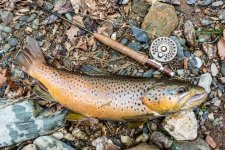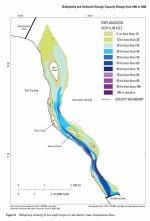Sorry for the delayed reply! Thanks for all of the comments.
I was on the way out when I wrote the first post, so I didn't get time to put more detail in it. Here's the detailed story:
Date: January 23, 2015
Rod: Orvis 7' 6" 3WT Superfine Trout Bum
Fly: Milky Sucker Spawn pattern tied by my nephew, size 10
Temperature: 42F
Water Temperature: 41F
This stream is like many other small streams in Lancaster and York counties that enter the Susquehanna--the steepest gradients are near the river. The upper portion is agricultural, so the water is warmed bit by the sun in the open fields but also subject to agricultural runoff. It is not stocked.
I enjoy fishing new locations, and I've fished dozens of streams in York and Lancaster county, always looking for new places to see and catch some trout. Half of the adventure is locating a new place to go and then seeing if there are trout there. This is an unlisted stream that I thought looked good, and I heard a rumor that it might hold trout, so I knew I had to visit--but it took me almost a year to do so. I visited it last week with my brother-in-law in part because I figured it was a good day for a drive and if there weren't any fish, it wouldn't be a big loss of prime fishing time.
We drove down from the upper reaches to the mouth and stopped along the way a few times--it was clearly a nice stream and better than I had thought based on the satellite images. We saw some smaller browns in some of the plunge pools and I missed one, but not a lot of feeding action. As we got down closer to where the stream enters the Susquehanna the gradient began to level out and the pools were deeper, longer and slower. Always a good location for the big fish, especially this time of year.
After stopping at several we saw a number of large fish all in one big pool with good structure for hiding. One was large enough that when we spooked it and it shot downstream it left a wake on the surface of the water, like a nuclear submarine cruising just below the surface. That fish had to be close to 30". It was enormous.
We worked that pool slowly and saw a few big fish and bumped a few but they just weren't feeding on anything we tossed. We tried a decent selection of the typical flies that work this time of year: stoneflies, case caddis, midge emergers, and even the classic San Juan worm. No go. We did see a shoal of suckers up near the top of the pool and several more large near them. Even the suckers weren't feeding.
We then moved on and explored a tributary and fished a few more pools. Still no go. As the late afternoon arrived I wanted to give one more shot at the big guys in the deep pool. I had not put my waders on earlier so I wasn't able to get a clean cast and drift to what we felt was the best part of the pool. Time to put them on and try before leaving.
My brother-in-law opted not to fish and just watched me work my up from the bottom of the pool. This time I was using a reddish-brown beadhead Kauffman stonefly nymph in size 8 and a milky sucker spawn fly as the dropper. Its a bit early for suckers to be spawning, but with all of them that we saw, we thought it was worth a shot. As I approached the head of the pool I finally had a bite and reeled in a sucker. In the process I saw several large trout in the 18-24" range swim around and I was concerned I had just spooked them and ruined any chances of catching one. To be honest, I didn't really expect to hook into a really large one, which is why i stayed with my light rod and reel.
On my first cast into the top of the pool I noticed from the drift that it was a bit deeper and a bit faster so I added some weight and moved my indicator up a foot. The next cast was perfect, right into the top edge of the pool, so I knew it would drift in to the best spot. As I watched my indicator, it slowly stopped and drifted down a bit. This time of year the fish tend to hit very lightly, so I set on everything like that. All day long it had always just been the bottom, and to be honest that was what I was expecting given the change in depth and weight.
For a brief second, I thought I was firmly snagged as when I lifted the rod and set, my line didn't move at all. Then he took off and I knew it was a BIG fish. I quickly worked in the extra line I had mended so I could work him on the reel and as I did he took off and the drag started singing. I quickly tightened the drag and bit and used my palm to help out. I also began backing down the pool to give myself more room to work him. I didn't want him trying to take me upstream out of the pool, or shooting past me and creating too much slack.
He alternated between turning and coming back and me and pulling very hard upstream. I keep the tension on the line and made sure he didn't break it or the road, which was doubled over every time he pulled. At times he pulled so hard that I simply walked upstream a little to prevent him from bending my rod too far or getting so much line out that I ran the risk of losing him in a slack moment.
My brother-in-law had seen the whole thing and was coaching me along the way. Meanwhile a passerby in a pickup truck saw me and stopped to watch. He was chatting with my BIL while I focused on the fish. While I could tell he was tiring out, so was I--my arm and shoulder were getting sore. The first time I tried to net him, he got a second wind and took off again. Luckily I was expecting that so I didn't leave and slack and lose him--I've lost a few big fish that way in the past.
As he used up his second wind I slowly worked my way back to the shallower water near the shore, as my net was not nearly big enough to fit him. Sure enough, as he got close and I managed to get the net on him, all that fit were his head and shoulders. As I stumbled to the shore, he flopped out of the net and the barbless hook popped out of his mouth. My BIL grabbed a quick picture while I grabbed my tape and did a quick measurement. He taped out at 23" and felt to me to weight similar to a bag of flour--five pounds or so--but I assumed less as I thought my excitement may have inflated my weight estimate. It was a fat and heavy fish. After the photo and measurement, I picked him him for the first picture I shared before the release. He was not out of the water long and I didn't put him on the ground by choice.
I promptly put him back in the water and as I was carrying him to a deeper spot he grunted at me. It made us laugh. I have an underwater camera and I tried to get a release shot, but I hadn't tired him out too much so he almost immediately took off and shot back into his hiding spot.
I don't spend much time hunting for larger fish but I always love catching one, and I have to say that this was a rush. The whole battle took over seven minutes--my BIL had checked his watch not long after I hooked him and then again when I netted him. It felt longer and in my mind I can still see my rod bent over and the flash of his orange belly as he battled to get free.
Jeff






